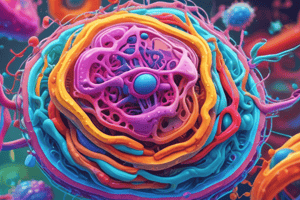Podcast
Questions and Answers
What is the main function of the Rough ER?
What is the main function of the Rough ER?
- Destroy old cell parts
- Barrier
- Transport materials
- Package proteins (correct)
Which organelle is responsible for O-type glycosylation?
Which organelle is responsible for O-type glycosylation?
- Cytoskeleton
- Smooth ER
- Rough ER
- Golgi Apparatus (correct)
What is the function of the Smooth ER?
What is the function of the Smooth ER?
- Package proteins
- Barrier
- Destroy old cell parts
- Transport materials (correct)
Which enzyme is involved in ethanol metabolism?
Which enzyme is involved in ethanol metabolism?
What is the function of the Golgi apparatus?
What is the function of the Golgi apparatus?
Where does protein synthesis mainly occur?
Where does protein synthesis mainly occur?
Which organelle is involved in Heme Synthesis?
Which organelle is involved in Heme Synthesis?
What controls what enters and leaves the cell?
What controls what enters and leaves the cell?
What anchors organelles inside the cell?
What anchors organelles inside the cell?
Which structure is involved in muscle contraction?
Which structure is involved in muscle contraction?
Flashcards are hidden until you start studying
Study Notes
Glucose-6-Phosphate and Calcium Storage
- Removal of phosphate from the 6th carbon of Glucose-6-Phosphate converts it to glucose.
- Sarcoplasmic reticulum (SR) in muscle cells stores Ca²⁺; analogous to smooth endoplasmic reticulum (E.R.).
- SR utilizes pumps to release calcium into the cytoplasm for muscle contraction and transport processes.
Golgi Apparatus
- Functions as the packaging organelle for proteins and lipids received from the rough and smooth E.R. respectively.
- Composed of two sides:
- Cis Golgi: Receives vesicles from E.R.
- Trans Golgi: Releases vesicles towards lysosomes, cell membrane, etc.
- Modifies proteins through processes such as:
- Glycosylation: Adding sugar residues; includes N-type (on nitrogen) and O-type (specific to Golgi on oxygen).
- Phosphorylation: Relevant in diseases like I-cell disease.
- Packages modified proteins and lipids, creating vesicles that can form lysosomal proteins, membrane proteins, or be excreted from the cell.
Cell Membrane Structure
- Composed of a phospholipid bilayer:
- Polar hydrophilic heads facing outward and inward.
- Nonpolar hydrophobic tails pointing towards each other.
- Contains cholesterol that regulates membrane fluidity. Increased cholesterol reduces fluidity by decreasing space between phospholipids, while decreased cholesterol increases fluidity.
Cell Membrane Proteins
- Integral and peripheral proteins serve various functions:
- Transporters for molecules.
- Enzymes facilitating biochemical reactions.
- Linker proteins connecting cells.
Cell Membrane Functionality
- Acts as a selectively permeable barrier, regulating the internal and external environment of the cell.
- Facilitates transport processes including:
- Simple Diffusion
- Facilitated Diffusion
- Vesicular Transport
Lysosomes
- Spherical organelles filled with hydrolytic enzymes crucial for breaking down waste materials within the cell.
Studying That Suits You
Use AI to generate personalized quizzes and flashcards to suit your learning preferences.




